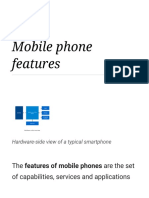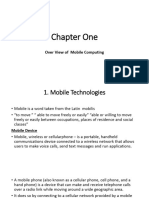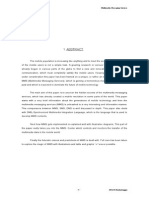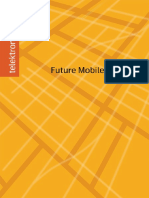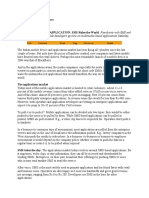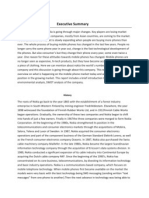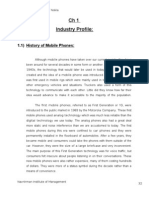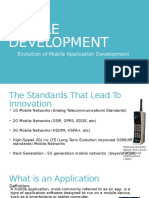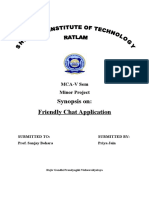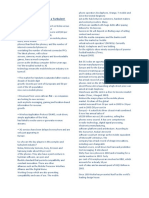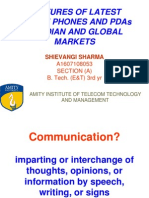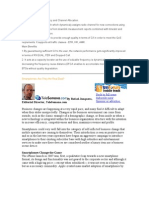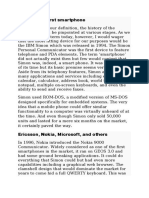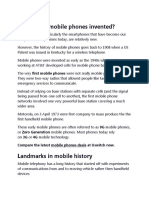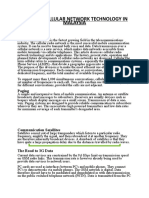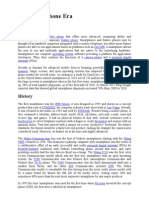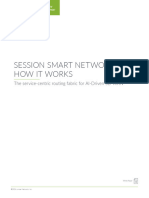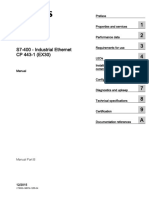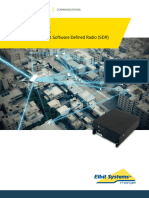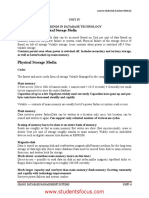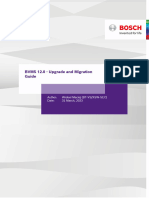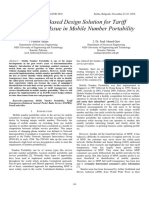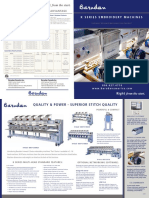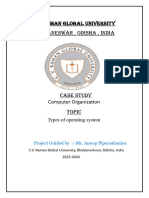Mobile Phone Evolution and Challenges
Uploaded by
stephanus andyMobile Phone Evolution and Challenges
Uploaded by
stephanus andyWhat’s next in mobile telephony and will it succeed?
NIGEL WILCOX
In the late nineties anyone who suggested that 3G would, in general, still be soft launching in late
2005 and that picture messaging and other new service revenues would be almost insignificant
would have been laughed at. The vast profits predicted for do-everything handsets have simply not
materialised. So what will the next generation of handsets contain and, more importantly, can they
make the networks some money?
Nigel Wilcox
works in the
Business Inno-
Introduction The SMS or text messaging revolution that followed
vation team at Back in the late nineties the whole mobile phone is also interesting: At school children write notes in
Philips’ semi- industry began setting itself up for 3G, investing vast the classroom and pass them to their friends, hope-
conductor amounts into network and handset developments and fully without the teacher noticing. Again, SMS is
division initial services like video telephony. So strong was simply an extension of our natural communicative
the thrust for 3G that no one noticed that some com- behaviour.
panies once generating healthy revenue from GSM
had stopped making money, devoting all their SMS and voice call services go 100% hand in hand.
resources into 3G and its new services whilst forget- Before mobile phones were commonplace, pagers
ting the current market. provided text-messaging functionality. SMS does
everything that a pager can, better than a pager can.
Most manufacturers designed phones that supported Critically, with SMS the phone used to call back a
every service to some extent and the handset market message sender is built into the message device: the
was segmented mainly by how well each unit per- two devices merge seamlessly.
formed these functions and how nice they looked.
Few subscribers used these new features but the
Mobile Network Operators (MNOs) subsidised them The mobile develops
in the hope that large new service revenues would The surprise success of converging pagers with mobile
soon appear. phones started everyone thinking what other applica-
tions or services could be combined with a phone.
We’re now at the end of 2005 and the new service There were “clearly” going to be many areas where
revenues are nowhere to be seen. The huge subsidies vast sums of money could be made by this do-every-
required cannot continue indefinitely – so what can thing communication device. Some of these did in-
the next generation of handsets contain to address the deed make a lot of money; others failed. For example:
industry’s problems?
WAP
To help predict the future let’s start by looking at the Wireless Application Protocol (WAP) was the first
past. new application to be implemented. It was a little like
browsing the Internet but using more efficient trans-
fer schemes for the relatively low bandwidth offered
Birth of the mobile phone by mobile networks.
People have talked to each other since they lived in
caves and always will do. Being able to talk to people At that time the Internet had just become available to
wherever they are is a clear step forward. The success everyone and some mobile networks started to pro-
of the mobile phone is therefore not surprising and mote WAP as “The Mobile Internet”. Whilst this was
the original mobile phone voice functionality is still a nice idea it was far too early – the beauty of the
today the mobile phone’s “killer” application. This Internet is that you can read pages and pages of on-
is unlikely to change. demand information and pictures on a screen. Hand-
sets just didn’t have the display capability and show-
The GSM mobile phone was a communications revo- ing a couple of lines of text that contained less infor-
lution as its single common European standard meant mation than old-fashioned TV teletext was not going
mobile phone technology became cheap enough for to be a hit with consumers.
everyone to own.
Telektronikk 3/4.2005 ISSN 0085-7130 © Telenor ASA 2005 85
WAP was not the mobile Internet but just a mobile Whilst Java solved compatibility problems to an
information service. The content on WAP did not extent, the mobile phone does not come close to
reflect this, which was a major factor in its lack of competing with the PC for programming or gaming.
appeal. Whilst WAP has improved dramatically over
the last few years, so has traditional internet brows- Java-based handsets can compete with dedicated
ing. Web browsing is also very cheap, so on content portable gaming devices like the Nintendo Game
and price WAP simply doesn’t compete. Boy, however: phone gaming has been a success with
a small but dedicated segment of mobile subscribers.
Java
As a phone contains all the elements of a basic com- As the components in handsets improve, the gaming
puter the idea of running applications or games on a experience on handsets will also improve allowing
phone should be appealing to a large number of PC the experience to improve and the market to expand.
and game console owners.
MMS
The real benefit to running software programs on a Multi-Media Messaging (MMS) allows picture,
phone, however, is that it can substantially increase sound and video clips to be attached to traditional
revenue for the MNOs – This could be through SMS/text messages. MMS was considered an obvi-
charged-for software downloads or application-initi- ous extension to an already very successful service
ated communication via the network. but usage has been incredibly poor and although
some MNOs are reporting a small improvement in
Unfortunately different handsets have different uptake, its use is still virtually zero.
screens, microprocessors and hardware architectures.
Program code cannot therefore run directly on every Creation of picture messages requires a camera and
phone. therefore increases Bill of Material (BOM) costs for
handset manufacturers. This translates to significantly
The Java programming language was invented by increased handset subsidies for the MNOs and so
Sun Microsystems with the intention of overcoming MMS is quite a heavy loss-maker.
problems of this nature by being platform indepen-
dent; i.e. Java applications written for one type of Surprisingly MMS service usage contrasts sharply
device can be run on any other Java device. with the use of camera phones themselves: people do
use the cameras for opportunistic photo opportunities
but they simply copy the pictures to their PCs rather
86 ISSN 0085-7130 © Telenor ASA 2005 Telektronikk 3/4.2005
ment of a comprehensive ring tone service very
straightforward.
The success of this service is probably due to every-
one’s desire to be different in some small way and
project a favourable image of themselves – fashion-
able, funny, etc. Importantly, phones are clearly natu-
rally good at playing ring-tones and this feature is a
seamless and cheap addition to the basic phone.
Music player phones
The Music Player Phone is the latest trend, yet it has
not been promoted by the industry anything like as
much as camera phones or the mobile Internet were.
The stand-alone portable music player market has
been consistently successful since the introduction of
the Sony Walkman in the late 1970s. The recoding
technology has moved on but the basic concept of a
good-quality portable music player remains the same.
Although it is relatively easy for a mobile phone to
include playback facilities for digitally stored music
the idea of using phones instead of dedicated music
players is only now taking off.
than send them to their friends or colleagues via the
mobile networks. First attempts at including this functionality only
enjoyed limited success due to storage capacities but
Although usage is low practically all networks are this is changing: Practically all new mobiles can now
still specifying cameras to be provided in all handsets play MP3 and other digital music formats and solid-
on their networks. This additional cost without rev- state memory is becoming cheap enough to include in
enue can’t go on forever but there is perhaps still sufficient quantity to store a large number of tracks.
hope for the success of MMS: The terror attacks on
London in the summer highlighted how useful cam- Most importantly, to make a real success of music
era phones can be to TV broadcasters who published phones from the MNOs’ point of view requires mech-
numbers and web sites for the public to send in their anisms allowing the mobile networks to derive rev-
images. The police force did the same to collect intel- enue from music sales. Copyright and licence issues
ligence and evidence. that have prevented success in this area are now
solved with Digital Rights Management (DRM), and
Encouragement by traditional news and entertainment download trigger technologies such as Near Field
television may be the kick-start MMS needs to be- Communication (NFC) will dramatically help sales.
come a viable service – but so far no such TV pro-
gramming has been developed.
Ring tones and wallpaper
Ring tones are very easy to produce and can easily be
downloaded over the air to handsets from third party
ring tone providers. Billing for this is almost always
handled by the network operators who take a sizable
slice of the revenue.
These services have been relatively simple to set up
and spectacularly successful. Ring tones account for
around 90 % of all network downloads to handsets.
Simple licensing has helped in the success of these
services – in the UK, for example, all fees are col-
lected by one licensing agency making the establish-
Telektronikk 3/4.2005 ISSN 0085-7130 © Telenor ASA 2005 87
With small improvements in storage and a set of Automatic configuration
stereo headphones the mobile phone has all the ingre- If a user purchases a new accessory for his device he
dients included in a portable music player – like all no longer needs to manually configure it (and proba-
other successful mobile applications, merging this bly call customer services in the process) but can sim-
functionality into a phone is easy. The portable music ply bring the two devices together. They will auto-
player also has a track record of being a successful matically share configuration data, pair with each
stand-alone application. Taking all this into account, other and start to work immediately.
music playing is very likely to become the must-have
phone feature in the next couple of years. Automatic music download
A billboard advertising a new music release can include
an NFC “Download Now!” logo. Swiping the phone
New technologies around the corner past the logo in the poster transfers a web address to the
So where does the mobile handset go now? – The handset from where the music track is downloaded.
number of new functions that can be added to a mobile
device is enormous. The following are some of those The user will simply see the message “Download
that are likely to be in handsets in the next few years. [song] now?” and with one click will automatically
load the track into the phone’s music store for playing
NFC later. These NFC readable tags behind the logo
Near Field Communication is a peer-to-peer wireless require no power supply (deriving power from the RF
connectivity system allowing convenient short-range of the nearby device) and are cheap to incorporate
communication between two devices. into printed media.
NFC moves on from traditional contactless RF ID Media licensing
systems as it can operate in two modes: active and A similar scheme can be used for movie license keys.
passive. Active mode allows bidirectional communi- The license would be transferred to the handset and
cation between two intelligent devices. Passive mode billed via the user’s phone subscription. When the
is similar to traditional RF ID where an intelligent handset is placed on a home video centre later that
device controls communication with a passive NFC- night, the movie can be automatically downloaded by
readable tag. the video centre and play authorised using the license
key from the handset.
By simply bringing two NFC-enabled devices to-
gether they can automatically establish communica- Smart keys and ticketing
tion between themselves without user configuration. The potential for access key applications including
transport or sports tickets is vast. The subscriber
Any kind of data can be transferred between devices would be able to have these downloaded to his phone
and so NFC provides a number of profit-enhancing via the MNO when purchasing a ticket or hotel room
opportunities. For example: on-line, saving on customer service costs and provid-
ing high-levels of security against fraud.
Transaction enabling
NFC can also be used as a payment mechanism, wire-
lessly and seamlessly transferring payment details
rather than using traditional cards or cash.
WLAN
Wireless Local Area Network (WLAN) is not a new
concept: Hot spots are now common in big cities and
areas where mobile people tend to congregate, such
as hotels, airports, etc.
WLAN is an excellent technology for connecting PCs
on a network and ideal for allowing PC users who are
static for short periods to download their e-mail or
surf the Internet. However, it does not easily provide
hand-over between cells or have an especially good
range but this doesn’t matter as laptop users will not
usually move when they are using WLAN.
88 ISSN 0085-7130 © Telenor ASA 2005 Telektronikk 3/4.2005
Whilst the charging for use of WLAN hot-spots
has so far been difficult, with many networks each
requiring their own log-in/credit-card charge, roam-
ing agreements are now being established that allow
simple log-in without the need for immediate pay-
ment. This makes the use of hot spots far more attrac-
tive for the average user.
WLAN connectivity could easily be added to mobile
phones. However, a standard mobile phone is not a
PC, and WAP may not offer enough to make most
users want to surf. Mobile phone WLAN connectivity
to the Internet is therefore likely to be only needed in
smart phones and GPRS or 3G modems.
There is, however, a killer application for WLAN on
all mobile phones ...: telephone calls. • Seamless “one phone” convergence of fixed and
mobile handsets in the home/office;
UMA
Unlicensed Mobile Access (UMA) is a general term • Transfer of subscribers from the GSM/3G air-inter-
for utilisation of licence-free radio for connection of face to WLAN when at home, freeing network
handsets to the MNO core network for voice and data capacity;
traffic.
• Use in aircraft via WLAN (some airlines have
The most common form of UMA utilises WLAN for Internet access already – e.g. Lufthansa on some
connection from the handset to a router in the home of its Atlantic services).
or office. This in turn is connected via an Internet
connection to the mobile network’s switching centre. The key benefit of UMA over standard Voice Over IP
(VoIP) systems is that it allows the MNO to maintain
GSM mobility mechanisms are employed allowing full control of (and therefore bill-for) all calls. Incom-
seamless handover between the GSM access network ing and outgoing calls are still routed through the
and UMA network. A UMA Network Controller MSC. The benefit for the subscriber is that the ser-
(UNC) is installed in the network that appears to the vice is seamless – he can always be contacted on his
Mobile Switching Centre (MSC) as just another set mobile number, does not have to load any special
of base stations. The handset searches for WLAN VoIP software, or need a high-level operating system.
“cells” in the same way it does for neighbour cells He simply initiates and receives calls as normal.
in a GSM network. The availability of these WLAN
cells is reported to the network in the usual way and
the network can select this cell for communication
with the handset just like any other.
GSM Cell
UMA cells can be WLAN hot spots already provided
GSM Cell
by the network for PC access, WLAN routers in sub-
Network Exchange Building
scribers’ homes, or specific UMA WLAN cells. UMA
is therefore cheap: the installation of a new UMA cell GSM Cell Base
station Core
requires primarily just a WLAN router and Internet
controller network
connection. Seamless handover
between GSM and mobile
UMA WLAN I switching
n UMA centre
UMA has numerous advantages for the mobile net- handset
t network
WLAN
works, including: e controller
r
n
• Very low-cost in-fill of small coverage black-spots; e
t
WLAN
• Low-cost capacity enhancement in small high-call-
WLAN
density areas (e.g. airport waiting lounges), freeing
GSM/3G cells;
UMA-GSM network architecture
Telektronikk 3/4.2005 ISSN 0085-7130 © Telenor ASA 2005 89
There are numerous possible extensions to the UMA some years away and standard GSM/3G bearers will
idea to allow, for example, zero-cost routing of roam- be used in the meantime for uplink data.
ing traffic to subscribers connected to a hotel’s
WLAN, etc. UMA is also a stepping-stone to IP- TV on mobile
based core network services, not a competing tech- TV “anywhere” is already available on some net-
nology. works but these services rely on the establishment of
a standard video telephony call to a server. The server
WLAN components are now very small. Philips answers the call with a video of the latest news or
802.11g WLAN system, for example, is available as weather bulletin, for example. These services are con-
System-in-Package (SiP) taking up only 150 mm2. sidered to be TV by the subscriber but they are actu-
The introduction of UMA will therefore have no ally download-on-demand video using dedicated
noticeable impact on physical size. Cost is also very bandwidth for that particular subscriber.
low given the potential up-sides and savings that can
be made. Digital Video Broadcasting for Handhelds (DVB-H)
is a standard for broadcast TV-on-Mobile that is
UMA offers packet data transfer in addition to voice likely to be adopted in large parts of the world. DVB-
– so high speed download of music triggered by NFC H uses an IP-based mechanism that can be used for
tag is a simple additional step. the broadcast of digital TV and anything else net-
works may want to transmit (e.g. software upgrades).
HSDPA
High-Speed Downlink Packet Access (HSDPA) is DVB-H technology is based on terrestrial digital TV
an extension to 3G that provides very high downlink standards, works now, and chip-sets will be available in
data rates from the network to the handset. Headline volume from a number of suppliers around the end of
rates are as high as 14 Mbps but in general most 2005. Each country has regulatory issues to overcome
phones will support up to 3.6 Mbps in the 2007/8 but the industry and governments are addressing these.
time frame.
Whilst DVB-H technology is proven its commercial
So far there have been few new services designed success depends entirely on the content and subscrip-
specifically for HSDPA but it will provide a mecha- tion models. Putting traditional TV content onto
nism to firmly move already successful Internet mobile phones is unlikely to work (just as the Mobile
applications into the mobile domain: high-speed con- Internet didn’t work): Most people are not going to sit
tent download to handsets and web-access (on PCs down at night with a beer and watch the football on a
via 3G HSDPA modem), for example. phone! Nor will they watch a drama programme –
traditional TV is great for this and critically most
High-Speed Uplink Packet Access (HSUPA) is an people watch this kind of entertainment television in
extension to HSDPA allowing fast data transfer from their free time.
the handset to network. At present this service is
90 ISSN 0085-7130 © Telenor ASA 2005 Telektronikk 3/4.2005
What subscribers will do is check the news headlines
whilst waiting for a train, or catch up on the spectacu-
lar crash they missed in the Formula 1 – i.e. short-
sharp video content subscribers can watch in the
spare moments of the day. Whilst people may also
want to watch extended programmes on a train, wire-
less coverage will have to be ubiquitous to prevent
any dropouts or the service would become unusable.
Whilst varying in the exact numbers quoted, different
recent studies show that with mobile-specific content,
a substantial proportion of mobile subscribers would
be prepared to pay monthly DVB-H service charges
of between three and ten euros. They will also pay
more for “premium” content.
Push-to-talk
Two-way radio is very common in some parts of the
world, particularly in North America. In Europe it has of the handset market. Stand-alone hardware GPS
been less successful probably due to higher popula- receivers need parallel hardware correlators to pro-
tion densities and traditionally higher cost. However, cess the satellite signals, which are unlikely to fall
the inclusion of a two-way Push-To-Talk (PTT) func- dramatically in price. Software-based GPS is far
tionality in a phone, as it already has all the necessary cheaper as it uses simpler receiver hardware and uses
components, is a relatively straightforward addition. software algorithms to determine a fix.
Push-To-Talk over Cellular (PoC) differs from tradi- The processing power needed to determine the loca-
tional two-way radio in that it uses the cellular net- tion in software is high. Time-to-fix is determined by
work to transfer speech to a server which then relays the processing power of the decoder’s microprocessor
it to the receiving subscriber(s). This has advantages – a slower CPU will require much more time to lock-
and disadvantages: It is secure; efficient in its use of on and decode the satellite signals. To shorten fix
bandwidth; requires network control and can there- times, or allow GPS functionality to be provided in
fore be charged-for. On the downside PoC may relatively low power processors, Assisted-GPS (A-
detract from use of SMS and traditional voice calls GPS) can be used. This employs a fixed land-based
and at the same time will not take-off if pricing is server that provides details of satellite location, time
too high. The key to its success therefore lies in the of day, etc., on request from the mobile. Once the
billing. A-GPS system is locked onto a location, tracking is
much easier.
PoC specifications are now complete but, due to
delays, competing systems have been established by For MNOs GPS allows a number of high value ser-
some networks and different PoC clients have already vices to be added including dynamic mapping/route
been included into handsets available now. This is a finding, traffic information and “find my nearest”
problem: until all networks adopt the common OMA applications. These services are already available in
PoC standard and all subscribers from all networks many networks but the lack of accuracy without GPS
can communicate together, PoC will not take off. limits their usefulness.
This was the case for SMS – use exploded once inter-
network messaging was possible. The hardware and software for A-GPS is available
now and should start to be included into many more
There is an education phase to go through too – in handsets over the next year.
America the walkie-talkie is a successful consumer
product; in Europe it is not and many people’s first Single Antenna Interference Cancellation
experience of two-way radio may be via PoC. PoC The spectral efficiency of GSM networks is partly
can also be tricky to set up – the use of NFC to pair limited by frequency re-use in nearby cells and the
devices for communication will help this a great deal. associated co-channel interference.
A-GPS Single Antenna Interference Cancellation (SAIC) is
The costs of full hardware Global Positioning Sys- a technique for improving downlink performance for
tems (GPS) have been prohibitive for a large part all GSM traffic channels by cancelling the largest
Telektronikk 3/4.2005 ISSN 0085-7130 © Telenor ASA 2005 91
each signal by analysing its strength and cancelling
the one causing the most interference.
SAIC cancels co-channel interference and adjacent-
channel interference caused by the spectral overlap
of neighbouring frequency channels. In this way the
carrier-to-interference ratio at the handset can be
improved significantly, leading to:
• Better voice quality
• Higher data throughput
• Fewer call drops
• Increased network capacity
SAIC allows more aggressive frequency re-use sce-
narios that could provide more than 40 % capacity
undesirable interference signal from local base sta- gain for GSM voice. Data services are also dramati-
tions, while processing the signal from the serving cally improved.
base station.
SAIC was recently standardised in GSM as Downlink
Users of GPRS, for example, often see their bit-rate Advanced Receiver Performance (DARP).
fluctuate between low and high throughput. This is
a symptom of interference from other base stations in Philips’ work on Mono Interference Cancellation
the area that are operating on different frequencies. (MIC) paved the way for SAIC and the company
In order to eliminate this interference SAIC passes continues to invest in research in the area: Many
the received signal through a filter that recognises advancements are in the pipeline.
Remove noise
from the received Gets the best out
speech of your speaker
Far-end noise
reduction • Auto voice clarity improvement
• Speaker equalization
• Noise controlled compressor
Received Reproduced far-end speech
far-end
speech
Improving Speaker
Speaker
Improving reproduction
High quality reproduction
far-end
far-end
acoustic echo improvement
improvement
canceller
Full duplex AEC for Acoustic
Acoustic
echo Echo
speakerphone Echo
cancellation
Cancellation noise
-
Improving
Improving Microphone
Microphone +
near-end
near-end improvement
Transmitted
near-end
Remove all types of
speech
noise from the
Near-end speaker
transmitted speech Microphone equalization
Noise reduction 1-mic dereverberation
• 1-mic stationary
• 2-mic (non-)stationary
Optimize microphone
operation and allow for usage
in all kind of rooms
Voice quality enhancement
92 ISSN 0085-7130 © Telenor ASA 2005 Telektronikk 3/4.2005
Since SAIC is implemented as software in the hand- Much improved audio will help drive sales of audio
set no network infrastructure modifications are and game downloads into handsets and other portable
required. devices.
Audio enhancements Enhancements to Hands Free
Given that the killer mobile application is still voice, Hands Free algorithms that provide the echo cancel-
a number of new software mechanisms that can lation needed for hands free systems have been im-
improve the sound quality of a call should improve proved to allow the use of full-duplex speech. Tradi-
network revenues significantly: tional systems use single-duplex that prevents the
callers interrupting each other.
Noise Void
The Noise Void algorithm removes the background Rollable displays
noise from the outgoing audio signal when calls are One of the biggest problems in introducing multi-
made in noisy environments such as bars or on public media services has been the limitation of the display.
transport. Calls that would otherwise be unintelligible This is not a traditional technology problem – better
can now be easily understood as noise is reduced by displays are available – the problem is that the dis-
more than 20 dB. play has to be small for hand-held devices yet needs
to be large in order to view multimedia content: A
Voice Clarity new approach is needed.
Voice Clarity algorithms work in the opposite way,
improving the incoming speech audio intelligibility. As a leader in display technologies, Philips has
The algorithm does much more than simply boosting invested heavily in this area and one solution is the
the volume of speech, as this would just introduce rollable display. This can be “hidden” inside a hand-
distortion. Voice Clarity also removes the need to set that is rolled-out when larger multimedia content
change volume levels to suit the environment. is to be displayed.
Both Noise Void and Voice Clarity encourage more, Prototypes exist now for this and allow reasonably
and longer, voice calls in noisy environments and do large displays to be incorporated in mobile devices.
not require any changes in the network. Within 2006 four-level grey-scale 5” diagonal dis-
plays of QVGA (320 x 240) resolution will be avail-
Concert Sound able in production volumes. Contrast on these devices
Mobile phone speakers and earphones are small and is better than most newspapers. Colour devices are
cannot provide concert-like reproduction on their also on the way but still require significant develop-
own. However, use of audio signal processing tech- ment and investment.
niques can dramatically improve the sound quality
perceived by the listener, without increasing the cost Aside from rollability and daylight readability,
of the headphone hardware. another key feature of rollable display technology
is its power consumption: Power is consumed only
Concert Sound systems use 3D surround sound pro- when the display image changes – once it is set it can
cessing algorithms that give a natural sound that feels be completely disconnected from a power supply.
as if it is coming from around the listener rather than
between the ears. Coupled with dynamic bass boost ULC
techniques that avoid clipping allows small head- It is estimated that approaching 80 % of the world’s
phones and built-in stereo speakers to produce excep- population live within range of a mobile network yet
tionally full and life-like sound. only around a quarter of the population subscribe to a
mobile phone service. There is therefore a vast num-
ber of the world’s population that could become
mobile phone subscribers – some 3.25 billion people.
These segments of the world population have earn-
ings that are only a small fraction of those in devel-
oped economies: for them to be able to subscribe to a
mobile service requires extremely cheap handsets and
call tariffs. The challenge is in making low cost hand-
sets and avoiding subsidies that cannot be repaid
through call charges.
Telektronikk 3/4.2005 ISSN 0085-7130 © Telenor ASA 2005 93
makers can expect to be able to build phones with
a Bill of Materials (BoM) around $20 in this time
frame. Looking forward this should reduce to $15
by 2008.
Is the subscriber tech’d-out?
The technologies listed above are the hot-topics at the
time of writing and there are many more around the
corner. But will subscribers use them?
At present people are not using multimedia services
partly because they are just too difficult to use and
also partly because consumers are overwhelmed by
the technologies available on their phones.
The GSM Association initiated work in this Ultra Whilst the industry needs to do all it can to make ser-
Low Cost (ULC) area last year by running a tender vices simple there is also an education and familiarity
for low cost handsets. A second round was also com- period which subscribers need to go through before
pleted earlier this year. mass adoption will occur.
In order to get costs down ULC handsets must pro- In general the mobile phone industry can move far
vide all functionality that is required and nothing that faster than consumers can keep up. Transparent fea-
is not. In a market that is driven by voice-calls and tures that improve the quality and use of existing ser-
SMS messages there is little room for cameras and vices, or help reduce cost should therefore be higher
other expensive additions that will be too costly to on the priority list of the industry as a whole. The
use anyway. Other critical factors in ULC markets are: industry also has to be careful not to release technolo-
gies too early that are then seen as a failure.
• Ruggedness – phone has to work;
• Battery life – easy access to mains power is not Convergence of technology and
available everywhere; features
Convergence is the buzzword of the moment. But
• Easy addition of features – the “must haves” of the what is it? Most consider it to be convergence of
future, e.g. FM radio or NFC; mobile, fixed line and Internet connectivity: Always
connected, to everyone and everything, everywhere.
• Low-cost brand differentiation.
As well as being compelling in its ease of use for the
It should be noted that these simplified handsets are subscriber, this “Connectivity Convergence” is also
not only useful for ULC markets – they also appeal to driven by competition. Many mobile operators, for
the “non-digital generation” in developed economies example, also have fixed-line businesses and face
– e.g. senior citizens and technophobes. These low fierce competition from cable companies for tele-
cost handsets make a compelling case for networks phony and broadband revenue. These operators are
that want to reduce subsidy. therefore looking for ways to offer better packages
that will prevent subscribers from switching to cable:
Different countries and brands have different defini- a combined, simple and seamless service of fixed-
tions of ULC so silicon vendors must have flexible line, mobile and broadband all through one subscrip-
solutions. tion is very attractive.
The long-term winners in these markets will optimize There is a second level of convergence applicable to
hardware partitioning for lowest cost and best perfor- handsets: “Functional Convergence”. This is the com-
mance yet retain design flexibility. bination of the functionality of two or more tradi-
tional devices into one.
Philips’ sub $5 chip set is available in sample form
now and will be ready for mass production in the Many of the services and functionality discussed so
middle of 2006. Together with the other components far will converge – but getting back to the aim of this
required in a phone (battery, display, plastics) handset article, which will be successful?
94 ISSN 0085-7130 © Telenor ASA 2005 Telektronikk 3/4.2005
Flexible, converged devices that
make sense and are simple to use
Connectivity Convergence will happen: Apart from
state monopolies (of which there are now very few),
networks that don’t embrace Connectivity Conver-
gence will lose revenue to their competitors who do
offer converged services.
Functional Convergence is more difficult. The mobile
industry is notoriously bad at predicting which ser-
vices will be a success and which will fail. What is
clear is that to be successful a service or function
must be 100 % suited to inclusion on a mobile device
and be as good or better than the device it replaces.
In addition to helping raise Average Revenue Per
User (ARPU), the handset industry can increase
Average Profit Per User without the subscriber even Due to the long development times of mobile phone
realising it through the use of capacity and quality chip-sets, to keep handset costs down semiconductor
enhancing technologies. As many subscribers are suppliers such as Philips have to provide flexible,
overwhelmed by handset technology at the moment core platforms with high-quality additional function
this may well be an area to concentrate on for the blocks that can be added or left-out as necessary.
next couple of years.
The functionality included in any device must be of
The cost of supplying integrated handsets that do excellent quality, or overall revenues will suffer as
everything is prohibitive. Networks are increasingly subscribers stick to their non-converged devices. If
shying away from high-tech, hard to use, include- great functionality is added well however, the future
everything devices with features that cost a lot but for new high-quality service profit is undoubtedly
are rarely used. very exciting.
Nigel Wilcox is a member of the mobile communications Business Innovation team at Philips’ semiconductor
division. He is principally involved in handset specification work with the mobile networks, ensuring Philips
chip-sets meet the network’s requirements, and therefore those of the handset manufacturers Philips sup-
plies. Prior to joining Philips he worked in engineering and project management roles for a number of com-
panies all involved in the development of mobile communications equipment and services. Nigel is a Char-
tered Engineer and member of the UK’s Institute of Electrical Engineers. He holds B.Eng and M.Sc degrees in
Electronic Engineering from Warwick and Nottingham Universities.
email: nigel.wilcox@philips.com
Telektronikk 3/4.2005 ISSN 0085-7130 © Telenor ASA 2005 95
You might also like
- Phone Evolution and Revolution: 65 - Trebol - Ing - Indd 16No ratings yetPhone Evolution and Revolution: 65 - Trebol - Ing - Indd 1614 pages
- Definition of "Contemporary": Having Particular Relevance To The Present TimeNo ratings yetDefinition of "Contemporary": Having Particular Relevance To The Present Time10 pages
- Evolution of Mobile Application DevelopmentNo ratings yetEvolution of Mobile Application Development39 pages
- Indoor Radio Planning: A Practical Guide For GSM, DCS, UMTS and HSPANo ratings yetIndoor Radio Planning: A Practical Guide For GSM, DCS, UMTS and HSPA3 pages
- An Introduction To Mobile Technologies and ServicesNo ratings yetAn Introduction To Mobile Technologies and Services27 pages
- Communication and Internet Technologies Form 3No ratings yetCommunication and Internet Technologies Form 38 pages
- Teal Yellow Red Creative Colorful Goal Setting Presentation 1No ratings yetTeal Yellow Red Creative Colorful Goal Setting Presentation 129 pages
- Synopsis On: Friendly Chat Application: MCA-V Sem Minor ProjectNo ratings yetSynopsis On: Friendly Chat Application: MCA-V Sem Minor Project12 pages
- Features of Latest Mobile Phones and Pdas in Indian and Global Markets100% (1)Features of Latest Mobile Phones and Pdas in Indian and Global Markets20 pages
- Three Topics That Continue To Be Misunderstood by The Wireless WorldNo ratings yetThree Topics That Continue To Be Misunderstood by The Wireless World15 pages
- By Rafael Junquera,: Smartphones: Are They The Real Deal?No ratings yetBy Rafael Junquera,: Smartphones: Are They The Real Deal?5 pages
- Mobile Technology Telecommunication: Early TelecommunicationsNo ratings yetMobile Technology Telecommunication: Early Telecommunications7 pages
- Current Cellular Network Technology in MalaysiaNo ratings yetCurrent Cellular Network Technology in Malaysia4 pages
- Learning & Certif Path Transport-ME - O&M IP Networking InfratelNo ratings yetLearning & Certif Path Transport-ME - O&M IP Networking Infratel22 pages
- ITDRI-WRD-220811-1251 Template Modul ITDRINo ratings yetITDRI-WRD-220811-1251 Template Modul ITDRI16 pages
- LEARNING-PATH-WIRELESS AKSES For People CompetenceNo ratings yetLEARNING-PATH-WIRELESS AKSES For People Competence7 pages
- T-27 - 2 Cloud Computing Concepts and Benefits - Teaching NotesNo ratings yetT-27 - 2 Cloud Computing Concepts and Benefits - Teaching Notes8 pages
- T-27 - 2 Cloud Computing Concepts and Benefits - Konten MateriNo ratings yetT-27 - 2 Cloud Computing Concepts and Benefits - Konten Materi39 pages
- Baseband Systems For Long Term EvolutionNo ratings yetBaseband Systems For Long Term Evolution34 pages
- Basics of Networking: Computer Network DesignNo ratings yetBasics of Networking: Computer Network Design41 pages
- Simatic Net S7-400 - Industrial Ethernet CP 443-1 (EX30)No ratings yetSimatic Net S7-400 - Industrial Ethernet CP 443-1 (EX30)80 pages
- Classification o F Physical Storage MediaNo ratings yetClassification o F Physical Storage Media21 pages
- WS011T00 Windows Server 2019 AdministrationNo ratings yetWS011T00 Windows Server 2019 Administration4 pages
- Huawei S5700-EI Switch Datasheet (17-Jul-2012) PDFNo ratings yetHuawei S5700-EI Switch Datasheet (17-Jul-2012) PDF12 pages
- Cybersecurity Controls Requirements - Dec 2022No ratings yetCybersecurity Controls Requirements - Dec 202218 pages
- EGPRS - Based Design Solution For Tariff Transparency Issue in Mobile Number PortabilityNo ratings yetEGPRS - Based Design Solution For Tariff Transparency Issue in Mobile Number Portability5 pages
- Types of Internet Connections: What Is The Internet?No ratings yetTypes of Internet Connections: What Is The Internet?4 pages
